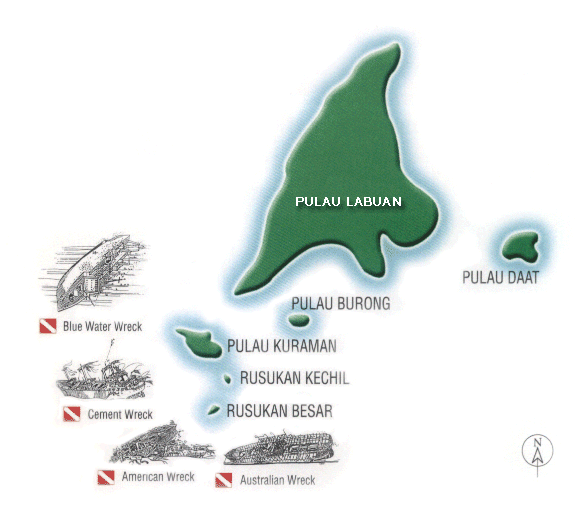 |
| Back | East Malaysia Map | West Malaysia Map | Water Sports | Trips Calender | Contact Titan | Email |
| PULAU LABUAN |
 |
|
Pulau
Labuan During
the early years, Labuan experienced battles between the Allied and the
Japanese Force, resulting in several war wrecks. Two of the World War
II wrecks here are the American Wreck and the Australian Wreck Other
wrecks include Cement Wreck and Blue Water Wreck, both from the 1980s. Diving The Cement Wreck can he dived by novices hut the Blue Water Wreck requires Advanced Divers or with logged experience. To penetrate into the two mentioned wrecks or to dive the American or Australian Wreck, you must be certified in wreck diving or have previously logged experience in wreck diving. Cement
Wreck The ship
sits perfectly upright on the bottom at about 30 metres. Her masts stand
at 8 metres, the roof of the wheelhouse at 14 metres and the main deck
at 19 metres. The position of the wreck makes it ideal for novice divers
and wreck diving training. Experienced divemasters would either descend to tie a line or would drop a rope weighted with molded lead as opposed to an anchor to prevent damage to corals and the wreck. Schools of baitfish congregating in huge groups greet divers as they descend the masts of the ship. As your eye adjust to the low light, the wreck reveals a profusion of coral and marine life. Soft corals in all shapes and colors lance with the currents. Small marine animals observed around the wreck include hawkfish, pipefish, damselfish, gobies, cardinal fish; the list is endless. The rich diversity of coral life also attracts bigger animals either to feed or to look for a cleaning station. The outer parameter of the wreck is patrolled by schools of fusiliers, batfish, barracudas and rainbow runners. This wreck offers the avid diver the most photogenic opportunity of all the wrecks. Australian
Wreck Nature has transformed what was once a lifeless wreck to rich coral growth with an abundance of marine life. The superstructure is covered with black coral tress, sea whips and stinging hydroids. A particular feature of the wreck is the presence of resident palm-sized frogfish or anglerfish. Large groupers can be seen swimming about looking for an easy feed among the profusion of marine life. Divers are forewarned where to place their hands as many stonefish and lionfish lie camouflaged around the wreck. American
Wreck During the Allied preinvasion of the Brunei Bay, while carrying out a routine mine sweep, the minesweeper struck a mine midship. She buckled when she sank, with the bow portion folding back over on top of the stern section. The wreck lies at 33 metres on the sandy bottom with tangled masses of metal and cable. Diving this wreck requires an experienced diver or a wreck diver to carefully explore the tangled mass. A feature of the wreck is the many fish-cleaning stations, crustaceans and echinoderms. The presence of spiny black urchins requires caution on the buoyancy of the diver when venturing close to the wreck. Depth chargers, ammunition shells, shoes culinary and wire bottles can be still found scattered around the wreckage, amidst mangled metal and cables. A resident school of spotted sweetlips lie as silent sentinels of the wreck. Getting
There Best
Time To Dive |
|
Titan
Dive Team
|